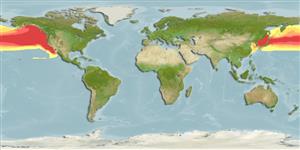>
Aulopiformes (Grinners) >
Notosudidae (Waryfishes)
Etymology: Scopelosaurus: Greek, skopelos = a lantern fish + Greek, sauros = lizard (Ref. 45335); harryi: Named after R.R. Harry, U.S. ichthyologist (Ref. 6885).
Eponymy: Dr Robert Rees (Harry-)Rofen (1925–2015) was an American ichthyologist. [...] (Ref. 128868), visit book page.
Environment: milieu / climate zone / depth range / distribution range
ນິເວດວິທະຍາ
ສັດທະເລ ກ່ຽວກັບ (ຢູ່) ຊັ້ນນ້ຳໃນທະເລເປີດທີ່ປອດແສງສ່ອງເຖິງ; ລະດັບຄວາມເລິກ 0 - 1500 m (Ref. 50550), usually 200 - 800 m (Ref. 43939). Deep-water; 60°N - 20°N, 121°E - 110°W
North Pacific: off Japan, throughout the California Current region (Ref. 35934) to the Aleutian Islands (Ref. 265); including Sea of Okhotsk and Bering Sea (Ref. 43939).
ຂະໜາດ / ນ້ຳໜັກ / Age
Maturity: Lm ? range ? - ? cm
Max length : 32.0 cm SL ຕົວຜູ້/ບໍ່ມີເພດ; (Ref. 43939)
ຄີ (ໜາມ)ແຂງຢູ່ຫຼັງປາ (ທັງໝົດ) : 0; ຄີຫຼັງຂອງປາ (ຄີອ່ອນ) (ທັງໝົດ) : 10 - 12; ຄີ(ໜາມ) ແຂງຢູ່ຄີກົ້ນປາ
ກຸ່ມປາກະດູກແຂງ
ຄວາມຖີ່ຂອງກຸ່ມຖ່າຍທອດພັນ
ປາທີ່ມີການເຄື່ອນຍ້າຍຈາກທະເລໄປຫານ້ຳຈືດ ແລະນ້ຳຈືດຫາທະເລ
ປາທີ່ມີການເຄື່ອນຍ້າຍຈາກທະເລແລະໄປໄຂ່ຢູ່ນ້ຳຈືດ
ຄີກົ້ນຂອງປາ
ສັດທີ່ມີກະດູກສັນຫັຼງ
ການຖ່າຍທອດທາງກຳມະພັນຈາກພໍ່ແມ່ຫາລູກ: 0; ຄີກົ້ນຂອງປາ: 16 - 19; ສັດທີ່ມີກະດູກສັນຫຼັງ: 58 - 61. Adipose fin small (Ref. 6885). Dark on head, body and fins; peritoneum, gills, and mouth cavity black (Ref. 6885). Branchiostegal rays: 10 (Ref. 35934).
Larger individuals apparently occur in deeper water than small ones (Ref. 4525). Synchronous hermaphrodites (Ref. 35934). Oviparous, with planktonic larvae (Ref. 35934). Juveniles makes nocturnal vertical migrations to the epipelagic zone (Ref. 43939). A planktivorous fish feeding mainly copepods and euphausiids (Ref. 35945).
Life cycle and mating behavior
ການຈະເລີນເຕັມໄວ | ການສືບພັນ | ການວາງໄຂ່ | ໄຂ່ | ຄວາມດົກຂອງໄຂ່ປາ | ຕົວອ່ອນ
Eschmeyer, W.N., E.S. Herald and H. Hammann, 1983. A field guide to Pacific coast fishes of North America. Boston (MA, USA): Houghton Mifflin Company. xii+336 p. (Ref. 2850)
IUCN Red List Status (Ref. 130435: Version 2024-2)
Threat to humans
Harmless
Human uses
ການປະມົງ:
ເຄື່ອງມື
Special reports
Download XML
ແຫຼ່ງອີນເຕີເນັດ
Estimates based on models
Preferred temperature (Ref.
123201): 0.3 - 7.2, mean 3.4 °C (based on 266 cells).
Phylogenetic diversity index (Ref.
82804): PD
50 = 0.5001 [Uniqueness, from 0.5 = low to 2.0 = high].
Bayesian length-weight: a=0.00295 (0.00121 - 0.00721), b=3.18 (2.96 - 3.40), in cm total length, based on LWR estimates for this (Sub)family-body shape (Ref.
93245).
ຊັ້ນເຂດຮ້ອນ (Ref.
69278): 3.1 ±0.0 se; based on diet studies.
ຄວາມຢືດຢຸ່ນ (Ref.
120179): ຕຳ່, ປະຊາກອນຕຳ່ສຸດທີ່ໃຊ້ເວລາສອງເທົ່າ 4.5 - 14 ປີ (Assuming tmax>10).
Fishing Vulnerability (Ref.
59153): Low to moderate vulnerability (29 of 100).
